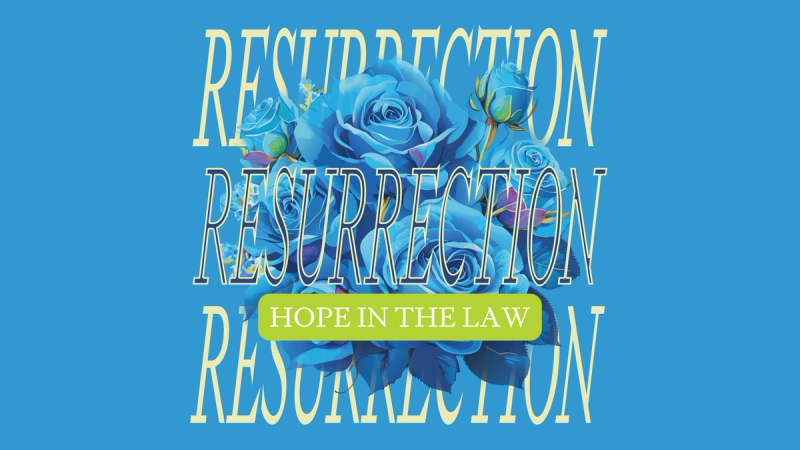Editor’s Note: The following is the first essay in a series of three, exploring the theme of resurrection in the Old Testament: The Law (Torah), the Prophets, and the Writings. We hope that these reflections will encourage you in this season as we celebrate Easter and the resurrection of our Lord Jesus Christ. Keep an eye out for the next two essays!
“If in Christ we have hope in this life only, we are of all people most to be pitied” (1 Cor. 15:19). New Testament believers are blessed with the hope of resurrection, but what of Old Testament saints? Were such blessings theirs? Did they have a conscious hope for the next life as well? According to the New Testament, the answer is yes. Paul stirred up the Pharisees against the Sadducees over the topic of the resurrection (Acts 23), and Martha confidently confessed that her brother would rise again (John 11). However, even this brings up several questions.
To what degree did Old Testament believers hope for resurrection? How did this understanding unfold in the Hebrew Scriptures? What difference did any of that make? This series will demonstrate that Old Testament saints showed a conscious hope of their resurrection, and (like New Testament saints) they received this hope from the pages of Scripture. Specifically, Old Testament saints met the Lord of the resurrection through the Law. That encounter made a difference in their lives, as it should in saints today.
Meeting the Lord of Resurrection in the Law
Abraham ascended Mount Moriah with his only son in tow. His intent was to sacrifice. His hope was resurrection. William C. Martin defines resurrection as “a restoration to life; revivification of a dead body.” Underlying this is the broader concept of life coming from death. This much occurs in nature. A seed falls, and a flower blooms. But actual resurrection is naturally impossible. Saints such as Abraham needed compelling reasons to believe otherwise. And compelling reasons they had.
Throughout the books of the Law, saints met God as the Lord of the resurrection, the one who kills and makes alive (Deut. 32:39). This essay will focus on how God’s lordship over resurrection unfolded in the book of Genesis. First, saints met the Lord as the one who gives life to the lifeless. They then met him as the one who gives life to the living (in a surprising way). Finally, they met him as the one who brings life from the dead.
Life to the Lifeless
In the Law, saints immediately met the God who gives life to the lifeless. God demonstrated this through all his creative acts in Genesis 1, but the narrative zooms in on the Lord giving life to man. “Then the Lord God formed the man of dust from the ground and breathed into his nostrils the breath of life, and the man became a living creature” (Gen 2:7). Though this verse speaks nothing of resurrection, its import should not be missed for it sets the stage for future resurrection acts. God took a lifeless human body and breathed the breath of life into it. Though this is not properly called resurrection, it establishes from the very beginning that the Old Testament believers were to know the God who gives life to the lifeless.
In this first week, the Lord established what Greg Nichols calls a paternal example. “God regulates Adam’s sonship by setting an example for his son to follow.” In this regard, the pattern was to provide life where there is none. The command to follow this pattern was made plain. Man was to multiply on the earth (Gen. 1:28). However, sin entered the world, and with it came complications in childbearing. Eventually, the narrative would introduce women who are barren and unable to bring forth life.
The wife of Abraham was one such woman (Gen. 11:30). Likewise, Abraham’s body was as good as dead (Rom. 4:19). Yet, God promised life to this lifeless womb, and in time he fulfilled his promise (Gen. 21:1–2). Unlike the singular act of creation, life from a lifeless womb became a repeated motif in the Old Testament. The Lord brought forth life from the barren wombs of Rebekah (Gen. 25), Rachel (Gen. 29), Sampson’s mother (Judg. 13), and Hannah (1 Sam. 2).
This theme, of course, doesn’t end in the Old Testament. Instead, it finds its ultimate purpose in the New Testament. Looking forward a bit, we see a girl not unlike Hannah from 1 Samuel. There is no way for her to bring forth life—not because she has a barren womb but because it is a virgin womb. Yet, the Lord does miraculously bring forth life from the virgin womb of Mary. And it’s no surprise! In the beginning pages of the Bible, the Old Testament believers met the Lord who gives life to the lifeless.
Life to the Living
Returning to the book of Genesis, despite the Lord’s provision of life to the lifeless, sin’s effects were already underway. By chapter four, when Cain killed Abel (Gen. 4:8), mankind physically realized the death promised as sin’s judgment. The next chapter drives home the point, in a rather repetitive way, that death is the future for men born of Adam. Eight times in chapter five alone, the bell tolls “and he died,” “and he died,” “and he died” (Gen. 5:5, 8, 11, 14, 17, 20, 27, 31).
Shockingly, this pattern of death is broken. On the would-be seventh repetition (making the pattern complete) Scripture reports these words instead: “Enoch walked with God, and he was not, for God took him” (Gen. 5:24). This is truly astounding! Before the pattern of death was completed, the Old Testament saints met the God who gives life to the living instead of death. Rare as it is for a man not to taste death, this is not the only occurrence of such a miracle. The Old Testament saint sees it again in the prophets when Elijah was taken to heaven in a whirlwind (2 Kings 2:1). Even this is not the last time a believer will be whisked heavenward. According to the New Testament, this is the fate of every living believer alive at Christ’s return (1 Thess. 4:17). While this too is not resurrection proper, the Old Testament Law nonetheless introduces the Lord as the one who gives life to the living instead of death.
Life from the Dead
Robert Gonzales Jr. argues well for “the spread of sin as one of the primary themes of [the Genesis narrative].” And as the curse of death unfolds, so unfolds the revelation of resurrection. In the Law, saints met the Lord as the one who brings life from the dead—at least figuratively. Evil spread throughout the world such that God decided to blot out his creation (Gen. 6:5–7). This pronouncement of judgment was decisive. Death had its day. Everything on the earth that had life died (Gen. 7:21–23). Death was everywhere.
From this worldwide death, the Lord brought up new life through Noah, his family, and the animals that were with them (Gen. 8:17). The earth had been pronounced dead, but through God’s saving act, the world was brought back to life. The implications are evident. Those who are in Christ “were buried therefore with him by baptism into death, in order that, just as Christ was raised from the dead by the glory of the Father, [they] too might walk in newness of life” (Rom. 6:4). Though the postdiluvian flood was not resurrection proper, in a massive way, the Lord was introduced as the one who brings life from death.
It has been conceded that these introductions throughout Genesis only figuratively showed God as the Lord of the resurrection. But were these figures and illusions enough to establish hope for resurrection in the real world? Abraham seemed to think so. Because he knew the Lord who gave life, he was ready to sacrifice his only son whom he loved, upon the Lord's command (Gen. 22:9–10). “He considered that God was able even to raise him from the dead, from which, figuratively speaking, he did receive him back” (Heb. 11:19). Saints like Abraham knew the Lord of life and hoped for the resurrection to come.
Conclusion
Through the Law, Old Testament saints were introduced to the Lord of the resurrection, and they showed themselves to be conscious of the resurrection hope that was theirs. They lived their lives according to this hope. Abraham lived in tents in a foreign land “for he was looking forward to the city that has foundations, whose designer and builder is God” (Heb. 11:10). They also died according to this hope. “By faith Joseph, at the end of his life, made mention of the exodus of the Israelites and gave directions concerning his bones” (Heb. 11:22).
Likewise (and to a greater degree), the New Testament believer has been introduced to the Lord of life and the God of the living (Matt. 22:32). He serves a resurrected Savior (Phil. 3:10) and awaits a day when he too will be raised (1 Cor. 15:52). Like Abraham, the New Testament believer is able to live in the confidence of the resurrection, storing up for himself treasures in heaven (Matt. 6:19–24). Like Joseph, he is able to die with the proclamation that he will one day reign with Christ in the resurrection (Rev. 20:6).
Footnotes
All Scripture citations in this work are taken from The Holy Bible: English Standard Version (Wheaton: Standard Bible Society, 2016) unless otherwise noted.
BackThat is to say that Old Testament believers both had actual reason to hope in the resurrection, and they were conscious of that fact. The reality of the resurrection did not escape them.
BackThe Layman’s Bible Encyclopedia (Nashville: The Southwestern Company, 1964), s.v. Resurrection.
BackThe text does not go into the same detail about the creation of woman, but something similar can be assumed. The Lord in some way bestowed life on a lifeless rib.
BackGreg Nichols, Lectures in Systematic Theology, vol II, Doctrine of Man, (Grand Rapids: Grace Immanuel Reformed Baptist Church, 2017), 410.
BackRobert R. Gonzales Jr., Where Sin Abounds: The Spread of Sin and the Curse in the Book of Genesis with Special Focus on the Patriarchal Narratives, (Eugene: Wipf & Stock, 2007), 72.
Back




